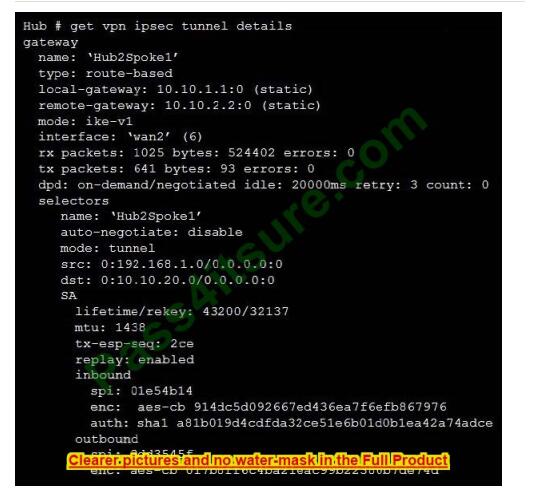
Hello everyone!
Today, I will be giving away a free set of NSE7_EFW-7.2 exam questions and answers to everyone!
First, you need to know some basic information:
The NSE7_EFW-7.2 exam questions are study materials for the 2025 Fortinet NSE 7 – Enterprise Firewall 7.2 exam! They replace the Fortinet NSE7_EFW-6.4 exam from before 2022 and the NSE7_EFW-7.0 exam from before 2025, and are used to validate skills in configuring, managing, and troubleshooting enterprise firewalls based on FortiOS 7.2.
You can try Pass4itsure’s NSE7_EFW-7.2 exam questions and answers: https://www.pass4itsure.com/nse7_efw-7-2.html. Currently, we have launched 80 of the latest exam questions and answers to help you accurately hit your target and successfully pass the exam.
Are you ready?
Below, I will share the latest practice materials for free.
Online Practice [July 2025] NSE7_EFW-7.2 Exam Questions
Question 1:
Exhibit.
Refer to the exhibit, which shows an ADVPN network.
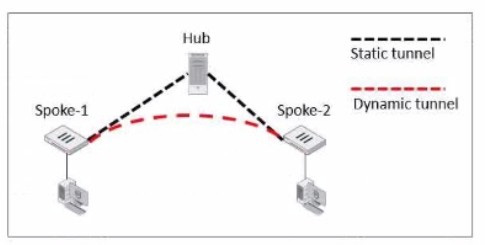
The client behind Spoke-1 generates traffic to the device located behind Spoke-2.
Which first message floes the hub send to Spoke-110 bring up the dynamic tunnel?
A. Shortcut query
B. Shortcut reply
C. Shortcut offer
D. Shortcut forward
Correct Answer: A
Explain:
In an ADVPN scenario, when traffic is initiated from a client behind one spoke to another spoke, the hub sends a shortcut query to the initiating spoke.
This query is used to determine if there is a more direct path for the traffic, which can then trigger the establishment of a dynamic tunnel between the spokes.
Question 2:
Refer to the exhibit.
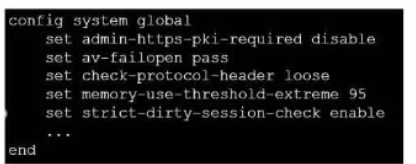
which contains a partial configuration of the global system. What can you conclude from this output?
A. NPs and CPs are enabled
B. Only CPs arc disabled
C. Only NPs are disabled
D. NPs and CPs arc disabled
Correct Answer: D
Explain:
The configuration output shows various global settings for a FortiGate device. The terms NP (Network Processor) and CP (Content Processor) relate to FortiGate\’s hardware acceleration features.
However, the provided configuration output does not directly mention the status (enabled or disabled) of NPs and CPs. Typically, the command to disable or enable hardware acceleration features would specifically mention NP or CP in the command syntax.
Therefore, based on the output provided, we cannot conclusively determine the status of NPs and CPs, hence option D is the closest answer since the output does not confirm that they are enabled. References: FortiOS Handbook – CLI Reference for FortiOS 5.2
Question 3:
You want to improve reliability over a lossy IPSec tunnel.
Which combination of IPSec phase 1 parameters should you configure?
A. fec-ingress and fec-egress
B. Odpd and dpd-retryinterval
C. fragmentation and fragmentation-mtu
D. keepalive and keylive
Correct Answer: C
Explain:
For improving reliability over a lossy IPSec tunnel, the fragmentation and fragmentation-mtu parameters should be configured. In scenarios where there might be issues with packet size or an unreliable network, setting the IPsec phase 1 to allow for fragmentation will enable large packets to be broken down, preventing them from being dropped due to size or poor network quality.
The fragmentation-mtu specifies the size of the fragments. This is aligned with Fortinet\’s recommendations for handling IPsec VPN over networks with potential packet loss or size limitations.
Question 4:
Which ADVPN configuration must be configured using a script on fortiManager, when using VPN Manager to manage fortiGate VPN tunnels?
A. Enable AD-VPN in IPsec phase 1
B. Disable add-route on hub
C. Configure IP addresses on IPsec virtual interlaces
D. Set protected network to all
Correct Answer: A
Explain:
To enable AD-VPN, you need to edit an SD-WAN overlay template and enable the Auto-Discovery VPN toggle. This will automatically add the required settings to the IPsec template and the BGP template.
You cannot enable AD-VPN directly in the IPsec phase 1 settings using VPN Manager.
References := ADVPN | FortiManager 7.2.0 – Fortinet Documentation
Question 5:
Refer to the exhibit, which shows a network diagram.
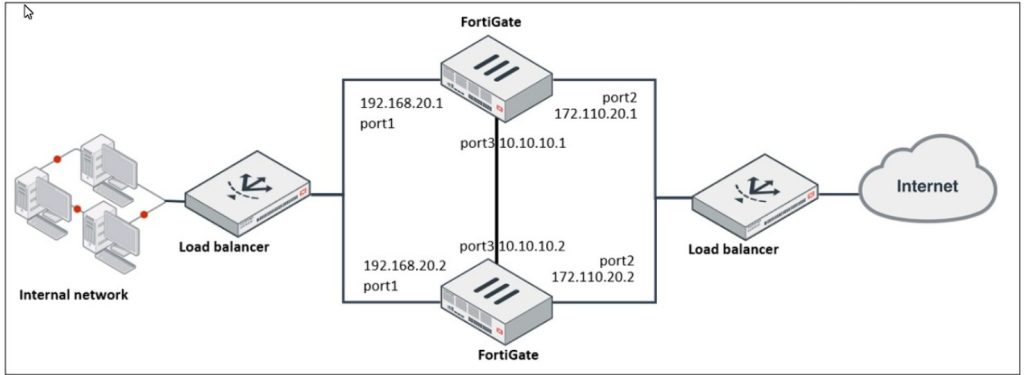
Which protocol should you use to configure the FortiGate cluster?
A. FGCP in active-passive mode
B. OFGSP
C. VRRP
D. FGCP in active-active mode
Correct Answer: A
Explain:
Given the network diagram and the presence of two FortiGate devices, the Fortinet Gate Clustering Protocol (FGCP) in active-passive mode is the most appropriate for setting up a FortiGate cluster.
FGCP supports high availability configurations and is designed to allow one FortiGate to seamlessly take over if the other fails, providing continuous network availability. This is supported by Fortinet documentation for high availability configurations using FGCP.
Question 6:
Exhibit.
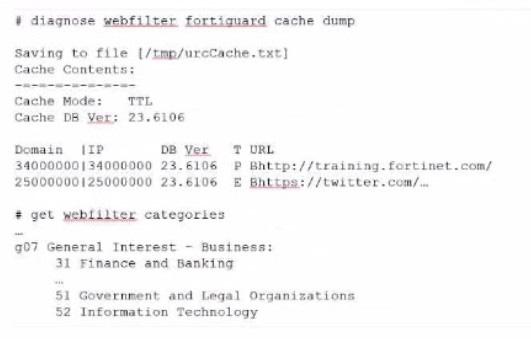
Refer to the exhibit, which shows the output from the webfilter fortiguard cache dump and webfilter categories commands.
Using the output, how can an administrator determine the category of the training.fortinet.comam website?
A. The administrator must convert the first three digits of the IP hex value to binary
B. The administrator can look up the hex value of 34 in the second command output.
C. The administrator must add both the Pima in and Iphex values of 34 to get the category number
D. The administrator must convert the first two digits of the Domain hex value to a decimal value
Correct Answer: B
Explain:
Option B is correct because the administrator can determine the category of the training.fortinet.com website by looking up the hex value of 34 in the second command output.
This is because the first command output shows that the domain and the IP of the website are both in category (Hex) 34, which corresponds to Information Technology in the second command output1.
Option A is incorrect because the administrator does not need to convert the first three digits of the IP hex value to binary.
The IP hex value is already in the same format as the category hex value, so the administrator can simply compare them without any conversion2.
Option C is incorrect because the administrator does not need to add both the Pima in and Iphex values of 34 to get the category number.
The Pima in and Iphex values are not related to the category number, but to the cache TTL and the database version respectively3.
Option D is incorrect because the administrator does not need to convert the first two digits of the Domain hex value to a decimal value.
The Domain hex value is already in the same format as the category hex value, so the administrator can simply compare them without any conversion2.
References: =
1: Technical Tip: Verify the webfilter cache content4
2: Hexadecimal to Decimal Converter5
3: FortiGate – Fortinet Community6 : Web filter | FortiGate / FortiOS 7.2.0 – Fortinet Documentation7
Question 7:
Which two statements about bfd are true? (Choose two)
A. It can support neighbor only over the next hop in BGP
B. You can disable it at the protocol level
C. It works for OSPF and BGP
D. You must configure n globally only
Correct Answer: BC
Explain:
BFD (Bidirectional Forwarding Detection) is a protocol that can quickly detect failures in the forwarding path between two adjacent devices.
You can disable BFD at the protocol level by using the “set bfd disable” command under the OSPF or BGP configuration. BFD works for both OSPF and BGP protocols, as well as static routes and SD-WAN rules.
References := BFD | FortiGate / FortiOS 7.2.0 – Fortinet Document Library, section “BFD”.
Question 8:
Refer to the exhibit, which shows two configured FortiGate devices and peering over FGSP.
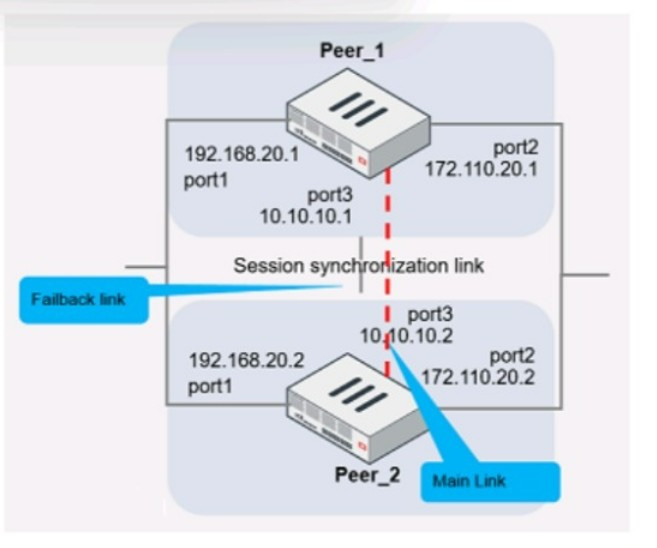
The main link directly connects the two FortiGate devices and is configured using the set session-syn-dev command.
What is the primary reason to configure the main link?
A. To have both sessions and configuration synchronization in layer 2
B. To load balance both sessions and configuration synchronization between layer 2 and 3
C. To have only configuration synchronization in layer 3
D. To have both sessions and configuration synchronization in layer 3
Correct Answer: D
Explain:
The primary purpose of configuring a main link between the devices is to synchronize session information so that if one unit fails, the other can continue processing traffic without dropping active sessions.
A.To have both sessions and configuration synchronization in layer 2.This is incorrect because FGSP is used for session synchronization, not configuration synchronization.
B.To load balance both sessions and configuration synchronization between layer 2 and 3.FGSP does not perform load balancing and is not used for configuration synchronization.
C.To have only configuration synchronization in layer 3.The main link is not used solely for configuration synchronization.
D.To have both sessions and configuration synchronization in layer 3.The main link in an FGSP setup is indeed used to synchronize session information across the devices, and it operates at layer 3 since it uses IP addresses to establish the
peering.
Question 9:
Which two statements about metadata variables are true? (Choose two.)
A. You create them on FortiGate
B. They apply only to non-firewall objects.
C. The metadata format is $.
D. They can be used as variables in scripts
Correct Answer: AD
Explain:
Metadata variables in FortiGate are created to store metadata associated with different FortiGate features. These variables can be used in various configurations and scripts to dynamically replace the variable with its actual value during processing.
A: You create metadata variables on FortiGate. They are used to store metadata for FortiGate features and can be called upon in different configurations.
D: They can be used as variables in scripts. Metadata variables are utilized within the scripts to dynamically insert values as per the context when the script runs. Fortinet FortiOS Handbook: CLI Reference
Question 10:
Exhibit.
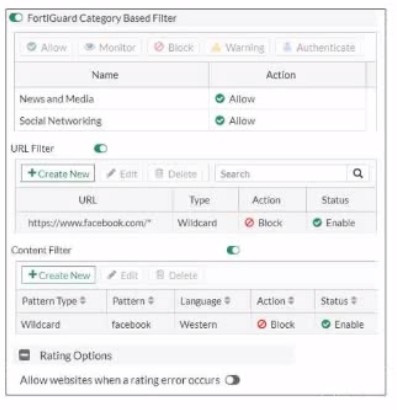
Refer to the exhibit, which shows a partial web filter profile conjuration
What can you cone udo from this configuration about access towww.facebook, com, which is categorized as Social Networking?
A. The access is blocked based on the Content Filter configuration
B. The access is allowed based on the FortiGuard Category Based Filter configuration
C. The access is blocked based on the URL Filter configuration
D. The access is hocked if the local or the public FortiGuard server does not reply
Correct Answer: C
Explain:
The access to www.facebook.com is blocked based on the URL Filter configuration. In the exhibit, it shows that the URL “www.facebook.com” is specifically set to “Block” under the URL Filter section1.
References := Fortigate: How to configure Web Filter function on Fortigate, Web filter | FortiGate / FortiOS 7.0.2 | Fortinet Document Library, FortiGate HTTPS web URL filtering … – Fortinet … – Fortinet Community
Question 11:
Refer to the exhibit, which shows an error in system fortiguard configuration.

What is the reason you cannot set the protocol to udp in config system fortiguard?
A. FortiManager provides FortiGuard.
B. fortiguard-anycast is set to enable.
C. You do not have the corresponding write access.
D. udp is not a protocol option.
Correct Answer: D
Explain:
The reason for the command failure when trying to set the protocol to UDP in theconfig system fortiguardis likely that UDP is not a protocol option in this context.
The command syntax might be incorrect or the option to set a protocol for FortiGuard updates might not exist in this manner.
So the correct answer is D. udp is not a protocol option.
Question 12:
Refer to the exhibit, which shows a custom signature.

Which two modifications must you apply to the configuration of this custom signature so that you can save it on FortiGate? (Choose two.)
A. Add severity.
B. Add attack_id.
C. Ensure that the header syntax is F-SBID.
D. Start options with –.
Correct Answer: AB
Explain:
For a custom signature to be valid and savable on a FortiGate device, it must include certain mandatory fields.
Severity is used to specify the level of threat that the signature represents, and attack_id is a unique identifier for the signature.
Without these, the signature would not be complete and could not be correctly utilized by the FortiGate\’s Intrusion Prevention System (IPS).
Question 13:
Refer to the exhibit, which contains information about an IPsec VPN tunnel.
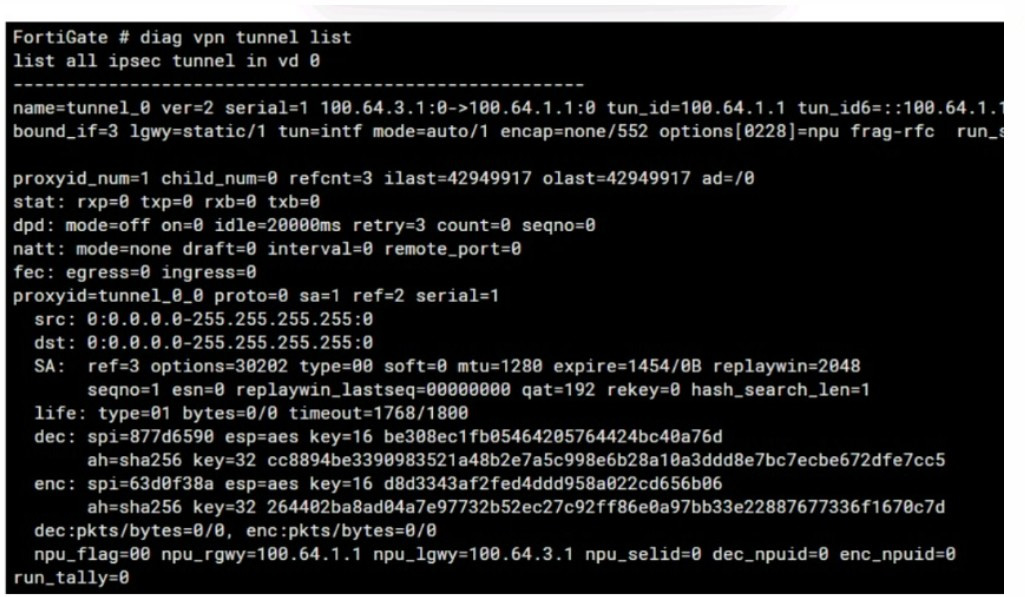
What two conclusions can you draw from the command output? (Choose two.)
A. Dead peer detection is set to enable.
B. The IKE version is 2.
C. Both IPsec SAs are loaded on the kernel.
D. Forward error correction in phase 2 is set to enable.
Correct Answer: BC
Explain:
From the command output shown in the exhibit:
B. The IKE version is 2: This can be deduced from the presence of \’ver=2\’ in the output, which indicates that IKEv2 is being used.
C. Both IPsec SAs are loaded on the kernel: This is indicated by the line \’npu flags=0x0/0\’, suggesting that no offload to NPU is occurring, and hence, both Security Associations are loaded onto the kernel for processing.
Fortinet documentation specifies that the version of IKE (Internet Key Exchange) used and the loading of IPsec Security Associations can be verified through the diagnostic commands related to VPN tunnels.
Question 14:
You want to configure faster failure detection for BGP
Which parameter should you enable on both connected FortiGate devices?
A. Ebgp-enforce-multihop
B. bfd
C. Distribute-list-in
D. Graceful-restart
Correct Answer: B
Explain:
BFD (Bidirectional Forwarding Detection) is a protocol that provides fast failure detection for BGP by sending periodic messages to verify the connectivity between two peers1.
BFD can be enabled on both connected FortiGate devices by using the command set bfd enable under the BGP configuration2.
References: = Technical Tip : FortiGate BFD implementation and examples …, Configure BGP | FortiGate / FortiOS 7.0.2
-Fortinet Documentation
Question 15:
Exhibit.
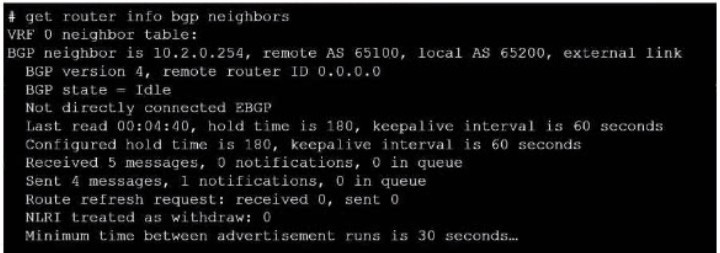
Refer to the exhibit, which provides information on BGP neighbors. Which can you conclude from this command output?
A. The router are in the number to match the remote peer.
B. You must change the AS number to match the remote peer.
C. BGP is attempting to establish a TCP connection with the BGP peer.
D. The bfd configuration to set to enable.
Correct Answer: C
Explain:
The BGP state is “Idle”, indicating that BGP is attempting to establish a TCP connection with the peer. This is the first state in the BGP finite state machine, and it means that no TCP connection has been established yet.
If the TCP connection fails, the BGP state will reset to either active or idle, depending on the configuration.
References: You can find more information about BGP states and troubleshooting in the following Fortinet Enterprise Firewall 7.2 documents: Troubleshooting BGP How BGP works.
Finally
The updated NSE7_EFW-7.2 exam questions and answers are ready. Welcome to use the latest exam materials – complete NSE7_EFW-7.2 exam questions at https://www.pass4itsure.com/nse7_efw-7-2.html (Q&As: 80).
If you also want to learn about FCP or FCSS, feel free to visit Pass4itsure.
Wishing you good luck!
